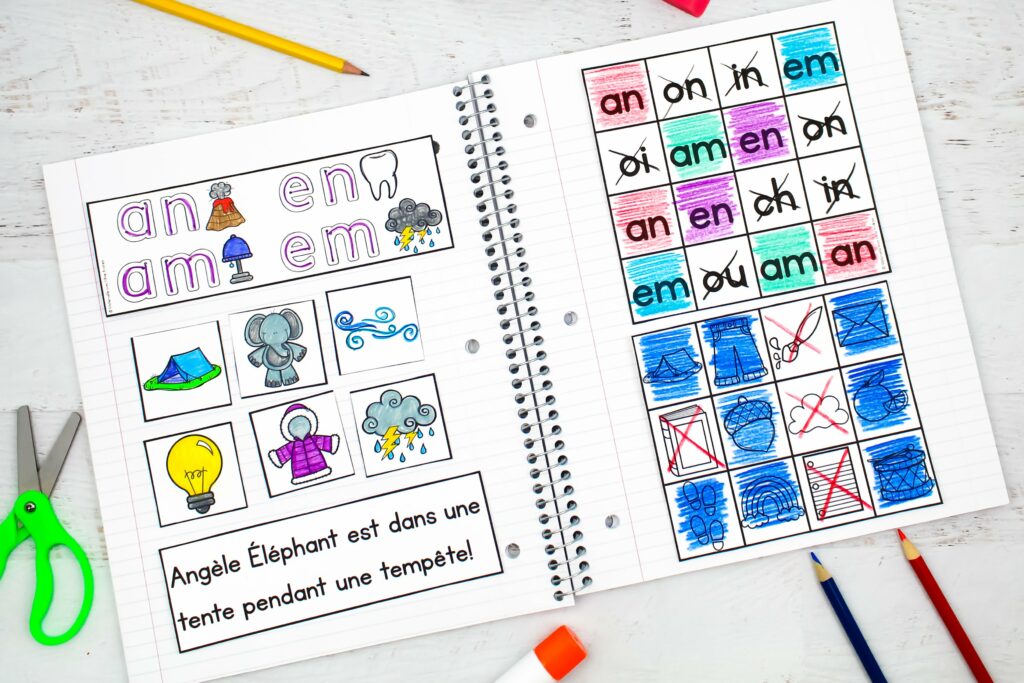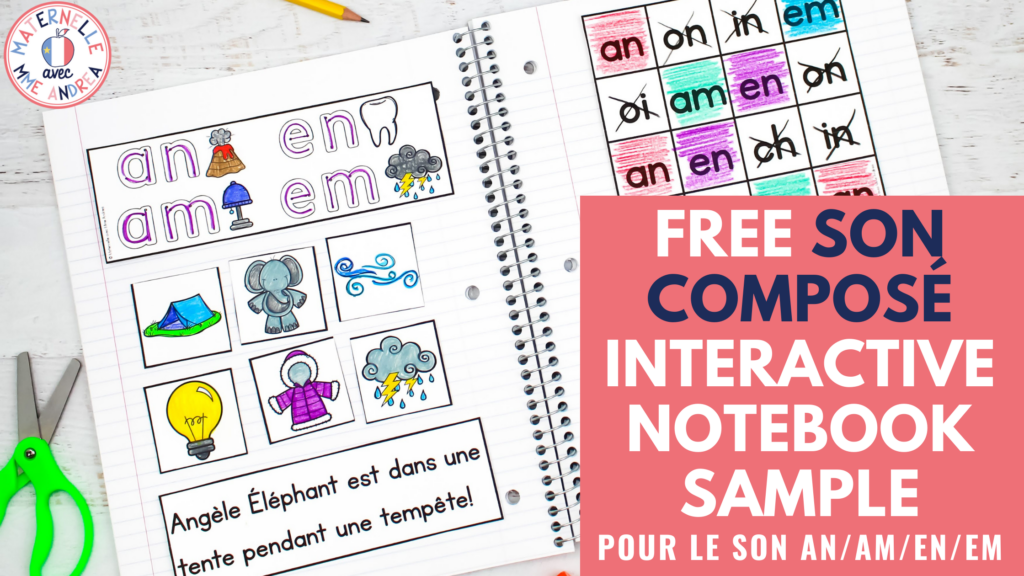One struggle that I’ve had with les sons composés as a French primary teacher? Teaching them in an effective, systematic way! You might be able to relate to this, depending on your school, but I have actually never been provided with a program or a curriculum to follow when teaching French phonics and sounds to my students.
So, when it was time to start introducing les sons composés, I was never really sure where to start. I’ve tried a BIG variety of routines and activities over the years. I’m so excited to share with you today what I have found works best!
A Slight Tangent Before We Start
I have never been provided a program or curriculum for teaching the alphabet, either. But a couple of years ago, after the pandemic, I decided to loop my maternelle students into grade one. I knew I would have to review the alphabet with them. So, I created a program myself called « Enseigner l’alphabet en 35 jours ».
Basically, it’s an interactive notebook for French Primary students that reviews one letter per day (Monday-Thursday). There is also a weekly review game for Fridays. It is quick and efficient and my students have always found a ton of success with it since I started using it.
A lot of other teachers have found success with it as well, and I’ve gotten many requests over the years to make a similar version for les sons composés.
So, last year, I finally took the time to make one for French phonics and sounds, too!
Today’s blog post is all about my son composé program, « Enseigner les sons composés ».
(This one doesn’t have a set number of days, because you can teach the sounds in any order you like and spend as much or as little time as you want on each one!)
What is « Enseigner les sons composés »?
This French phonics program is an interactive notebook that teaches one sound per lesson. You don’t have to do one sound per day, because that might be too quick of a pace for your students. But you can, especially if you are using this program as review!
You can also always supplement this program with other activities that you like to do for each sound. For example, I do this program alongside my Son Composé Blending Books.
I aim to teach 2 sounds per week using this method. But, we just work on the interactive notebook piece one day per sound. So, for example, Monday we would do the interactive notebook piece, and Tuesday we would do something else for the same sound. Wednesday and Thursday, we would do the same for a new sound.
Then, on Friday, we would review the two sounds that we learned that week along with all of the other sounds that we learned in previous weeks via the review game included in the resource.
In order to use this program, your students will need somewhere to glue their activities – like a notebook. I like to use a coil scribbler that I get from Staples every summer for $0.25 per student.
Each student will also need scissors and glue. All of the cuts are straight cuts, so they are pretty easy for students to do on their own. It’s a great activity for working on fine motor skills!

What’s Included in this Sons composés resource
First, this resource includes posters for each sound. These are for the teacher to use with the French phonics lessons and then display in the classroom. You can use these posters to introduce and review each sound.
Each sound has two types of posters. One poster features the sound + all of the ways to spell it, and there is a second poster for each sound individually.
You can use one type of poster or both types of posters – totally up to you!
After you introduce each sound, you will also teach students six new vocabulary words that contain the target sound to your students. There are scripted lessons that give suggestions for exactly what to say.
The sound might be at the beginning, in the middle, or at the end of the word. I suggest getting your students to repeat the word a few times and then identify where the target sound is in the word.
In their notebook, students will glue the heading piece and trace all the spellings of the sound. Certain sounds have more than one spelling. On the headers I have included any of the spellings that are composed of two or more letters. You may also choose to have students write the ways to represent the sand with a single letter underneath or beside this heading, where applicable.
(For example, au/eau can also be written as o, but that is not a son composé, so o is not written on the header for students to trace.)
Students will also have a black and white version of the six vocabulary words for each sound to glue underneath the header.

The next activity is a silly sentence. Each lesson has a sentence full of words containing the target sound. Students will listen to you read the sentence and then repeat it as many times as they need to remember it.
Then, they will look at the sentence in their notebook and circle each instance of the target sound.
The third activity is a “look and find”. This activity will help students pay attention to all of the spellings of the target sound.
In the grid, students will circle or colour the correct spelling of the target sound. You can also have students mark an x on any incorrect spellings. My students love making Xs!
The final activity is another look and find. This time, students will look at the images in the grid. They will say each word, and then decide if the target sound is found inside of that word or not. This is a great activity for encouraging students to listen for the target sound in a variety of words. Yay for conscience phonologique!
Again, students can colour or circle the words that do contain the sound and they can mark an X on those that do not. I suggest reviewing the vocabulary before sending students off to do this work.
All of these activities can be glued in a two-page spread in your students’ notebooks. Below is a picture of how I suggest you set it up:

I have my students cut and glue their own work, every time. It can take practice for them to do it correctly, but they are very capable! In my classroom, students do all tasks that they are able to do. Even if it sometimes doesn’t look as nice as it would if I did it! ;)
Again, all of these activities are straight cut only. Your students should have no problem cutting them out on their own.
Sons composés Review Game
There is also a review game included in the Enseigner les sons composés resource, with a gnome theme. Your students will love searching for the gnome(s) hiding behind the words containing the target sounds they have learned.
What I like about the game is that it’s the same structure each week, but you can just switch out the cards. This helps encourage students to practice decoding words that contain the new sounds they have learned.
You can use the game to review all of the sounds you have taught up to that point in time.
Other Suggestions for This Sons composés Resource
My students often enjoy using a highlighter to complete these activities. We don’t use highlighters very often in my classroom, so if it’s a group that really enjoys highlighters, this can be motivating for them.
You could also have students use markers, coloured pencils, crayons… whatever you like!
To help keep the scribblers neat, you might want to collect them in a pile each day and then hand them out again the following day. Or, you might have students keep track of their own scribblers in their own supply boxes.
When our interactive notebooks are complete, I like to send them home right away so parents can see which sounds their children have learned and how they did with the activities.
Remember, if your students aren’t ready for these sounds yet, I do have an alphabet version of this resource as well.
And, if you find you have some students who need more time to master each sound, don’t forget about my Apprendre les sons composés resource, which allows students to work through sounds at their own pace.
Conclusion
It has been SO reassuring for me to know that I now have an effective, systematic program that I can use to help teach my students French phonics and learn all of the son composés they need to know in grade one.
By doing two sounds per week (after we have learned the alphabet) my students are better able to remember, identify, and read the sounds in the words in their books.
Displaying and reviewing the sound posters each day has also really helped my students master their sounds!
If you’re interested in adding an interactive notebook to your son composés teaching, I do have a free sample you can try for the sound an/en/am/em.
Just click HERE to sign up and download your copy of the free sample!
And, if you want the whole thing, you can click here to see it on TPT.



